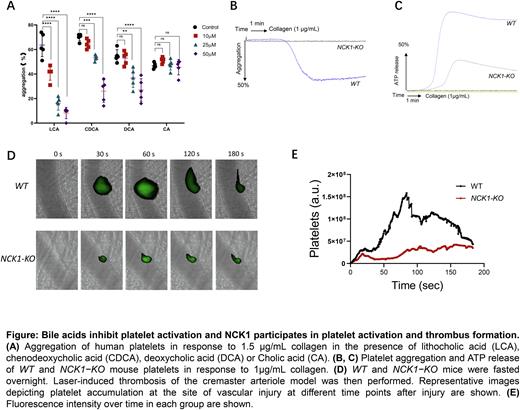Abstract
Background and Aims: Platelet aggregation is essential for normal hemostatic process when blood vessels are injured. However, aberrant platelet activation causes cardiovascular diseases such as thrombosis, atherosclerosis, and myocardial infarction. Multiple antiplatelet drugs are needed for patients at risk of thrombosis. Therefore, it is particularly important to further study mechanisms of regulating platelet activation, especially the physiological inhibition factors of platelet homeostasis. Bile acids (BAs) play important roles in eliminating cholesterol and solubilizing lipid nutrients. Recently, BAs have been recognized as signaling molecules through activating the nuclear receptor, FXR. However, the role of bile acids remains to be elaborated. Therefore, it's significant to explore the functions of bile acids in platelet activation and clarify mechanisms of bile acids in platelet homeostasis.
Methods: Platelet aggregation, adhesion experiment and flow cytometric analysis were used to explore the role of BAs in platelet activation. Ferric chloride-induced carotid injury model was used to establish the influence of BAs on thrombus formation in Wild-type C57 mice. Proteomic analysis revealed the important role of noncatalytic region of tyrosine kinase (NCK1) in the inhibition of collagen-stimulated platelet activation by bile acids, and we further validated the effect of NCK1 on platelet activation and thrombus formation in NCK1-deficient mice.
Results: Different bile acids had different inhibitory effects on platelet activation. We found that secondary bile acids have more inhibitory effects than primary bile acids, and among secondary bile acids, lithocholic acid (LCA) has the most significant inhibitory effect (Figure A). In the process of platelet activation, the inhibition of bile acid on Ca2+ internal flow exhibited a concentration - dependent effect. Bile acids suppressed platelet activation via Syk, PLCγ2, PI3K, Akt and ERK1/2 pathway in time-concentration dependence. In addition, we found that NCK1 deficiency significantly suppresses the activity of platelets in response to agonists, and inhibits arterial thrombosis (Figure B-E). Our results also suggested that LCA may be involved in the integrin αIIbβ3 signaling pathway that regulates platelet activation. Phosphorylated proteomics analysis revealed that LCA inhibited phosphorylation of Syntaxin-11 at S80 in platelets. Co-immunoprecipitation assay also confirmed that phosphorylation at the serine site of Syntaxin-11was inhibited by LCA in platelet, suggesting that Syntaxin-11 may play an important role in platelet activation.
Conclusions: Bile acids play critical roles in platelet activation via Syk, PLCγ2, PI3K, Akt and ERK1/2 pathway, which was associated with NCK1 protein kinase. Anti-platelet studies of bile acids provide theoretical basis for the development of new antiplatelet agents.
Disclosures
No relevant conflicts of interest to declare.
Author notes
Asterisk with author names denotes non-ASH members.


This feature is available to Subscribers Only
Sign In or Create an Account Close Modal